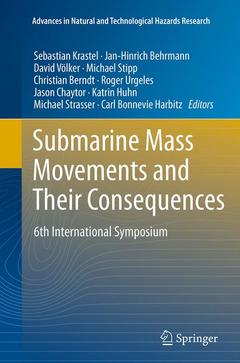Description
Submarine Mass Movements and Their Consequences, 2014
6th International Symposium
Advances in Natural and Technological Hazards Research Series, Vol. 37
Coordinators: Krastel Sebastian, Behrmann Jan-Hinrich, Völker David, Stipp Michael, Berndt Christian, Urgeles Roger, Chaytor Jason, Huhn Katrin, Strasser Michael, Harbitz Carl Bonnevie
Language: English
Keywords
Marine Hazards; Mass-movement; Submarine Landslide; Tsunamis
Submarine Mass Movements and Their Consequences
Publication date: 08-2016
Support: Print on demand
Publication date: 08-2016
Support: Print on demand
Submarine Mass Movements and Their Consequences
Publication date: 09-2013
683 p. · 15.5x23.5 cm · Hardback
Publication date: 09-2013
683 p. · 15.5x23.5 cm · Hardback
Description
/li>Contents
/li>Comment
/li>
Submarine mass movements are a hidden geohazard with large destructive potential for submarine installations and coastal areas. This hazard and associated risk is growing in proportion with increasing population of coastal urban agglomerations, industrial infrastructure, and coastal tourism. Also, the intensified use of the seafloor for natural resource production, and deep sea cables constitutes an increasing risk. Submarine slides may alter the coastline and bear a high tsunamogenic potential. There is a potential link of submarine mass wasting with climate change, as submarine landslides can uncover and release large amounts greenhouse gases, mainly methane, that are now stored in marine sediments.
The factors that govern the stability of submarine slopes against failure, the processes that lead to slope collapses and the collapse processes by themselves need to be better understood in order to foresee and prepare society for potentially hazardous events. This book volume consists of a collection of cutting edge scientific research by international experts in the field, covering geological, geophysical, engineering and environmental aspects of submarine slope failures. The focus is on understanding the full spectrum of challenges presented by this major coastal and offshore geohazard.
The factors that govern the stability of submarine slopes against failure, the processes that lead to slope collapses and the collapse processes by themselves need to be better understood in order to foresee and prepare society for potentially hazardous events. This book volume consists of a collection of cutting edge scientific research by international experts in the field, covering geological, geophysical, engineering and environmental aspects of submarine slope failures. The focus is on understanding the full spectrum of challenges presented by this major coastal and offshore geohazard.
Physical properties of sediments.- Gas hydrates and role of interstitial fluids in submarine slope failure.- Slope stability and risk assessment.- Monitoring, observation and repeated surveys of active slope failure processes.- Understanding failure processes from submarine landslide geomorphology.- Interaction between ocean circulation and MTDs.- Landslide generated tsunamis.- Long-term record of submarine landslides and MTD paleoseismology.- Outcrops of ancient submarine landslides.
Unique subject that is addressed in very few other publications and interest is growing rapidly State of knowledge of submarine mass movements and their consequences Engineering and environmental considerations of submarine slope failures Tsunami potential of submarine mass movements Includes supplementary material: sn.pub/extras
© 2024 LAVOISIER S.A.S.




